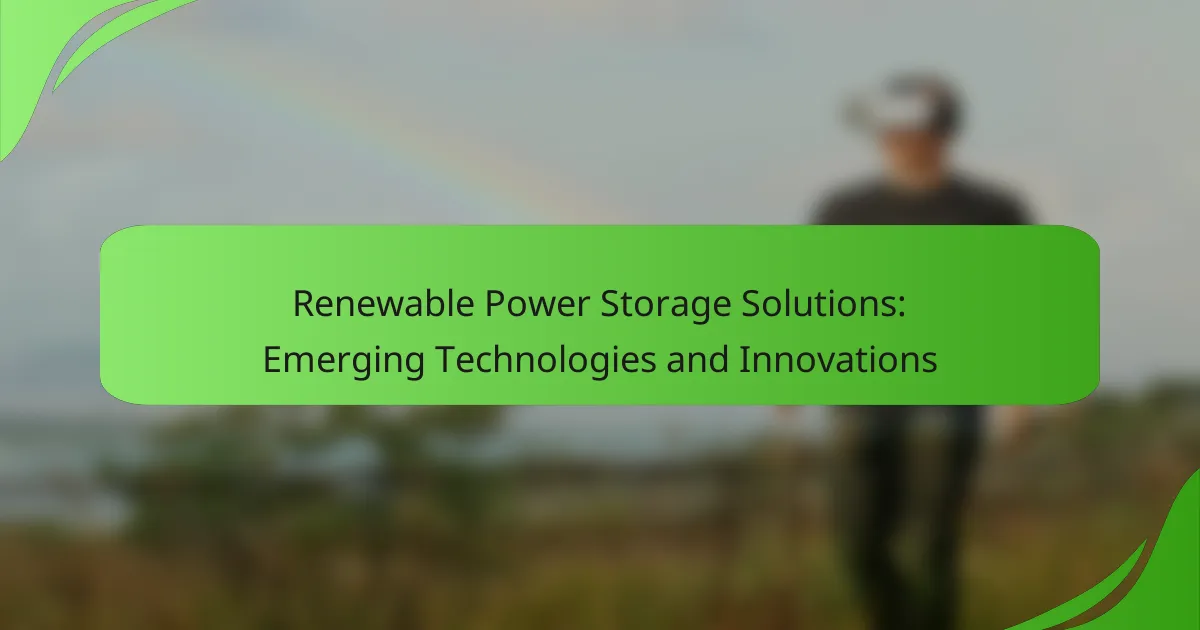As the demand for renewable energy continues to grow, effective power storage solutions are becoming increasingly vital. Technologies such as lithium-ion batteries, flow batteries, and pumped hydro storage are at the forefront, each offering distinct advantages and challenges. Innovations in energy storage, driven by advancements in battery management systems and artificial intelligence, are enhancing efficiency and reducing costs, making renewable energy more accessible and sustainable.

What are the best renewable power storage solutions in the United States?
The best renewable power storage solutions in the United States include lithium-ion batteries, flow batteries, pumped hydro storage, compressed air energy storage, and solid-state batteries. Each of these technologies offers unique benefits and challenges, making them suitable for different applications in the renewable energy landscape.
Lithium-ion batteries
Lithium-ion batteries are widely used for energy storage due to their high energy density and efficiency. They are commonly found in electric vehicles and residential solar energy systems, providing quick discharge and recharge capabilities.
However, they can be expensive and have a limited lifespan, typically lasting around 10-15 years. When considering lithium-ion batteries, it’s essential to evaluate the total cost of ownership, including installation and replacement costs.
Flow batteries
Flow batteries store energy in liquid electrolytes, allowing for scalable and long-duration energy storage. They are particularly useful for large-scale applications, such as grid storage, where energy can be stored for hours or even days.
While flow batteries have a longer lifespan compared to lithium-ion batteries, they tend to have lower energy density and higher upfront costs. It’s crucial to assess the specific energy needs and operational requirements before choosing flow batteries for a project.
Pumped hydro storage
Pumped hydro storage is a mature technology that uses two water reservoirs at different elevations to store energy. During low demand, excess electricity is used to pump water uphill, and during high demand, the water is released to generate electricity.
This method is highly efficient and can provide large-scale energy storage, but it requires significant geographical considerations and infrastructure investment. Sites for pumped hydro must have suitable topography and water availability, which can limit their deployment in some regions.
Compressed air energy storage
Compressed air energy storage (CAES) involves storing energy by compressing air in underground caverns or tanks. When energy is needed, the compressed air is heated and expanded to drive turbines for electricity generation.
CAES systems can provide large-scale storage solutions but may require substantial geological formations for implementation. They are less common than other technologies but can be effective for balancing grid demand and supply.
Solid-state batteries
Solid-state batteries are an emerging technology that replaces the liquid electrolyte in lithium-ion batteries with a solid electrolyte. This innovation can enhance safety and energy density while potentially reducing costs over time.
Although solid-state batteries are still in the development phase, they hold promise for applications in electric vehicles and renewable energy storage. Monitoring advancements in this field is essential for future energy storage solutions, as they may become commercially viable in the coming years.
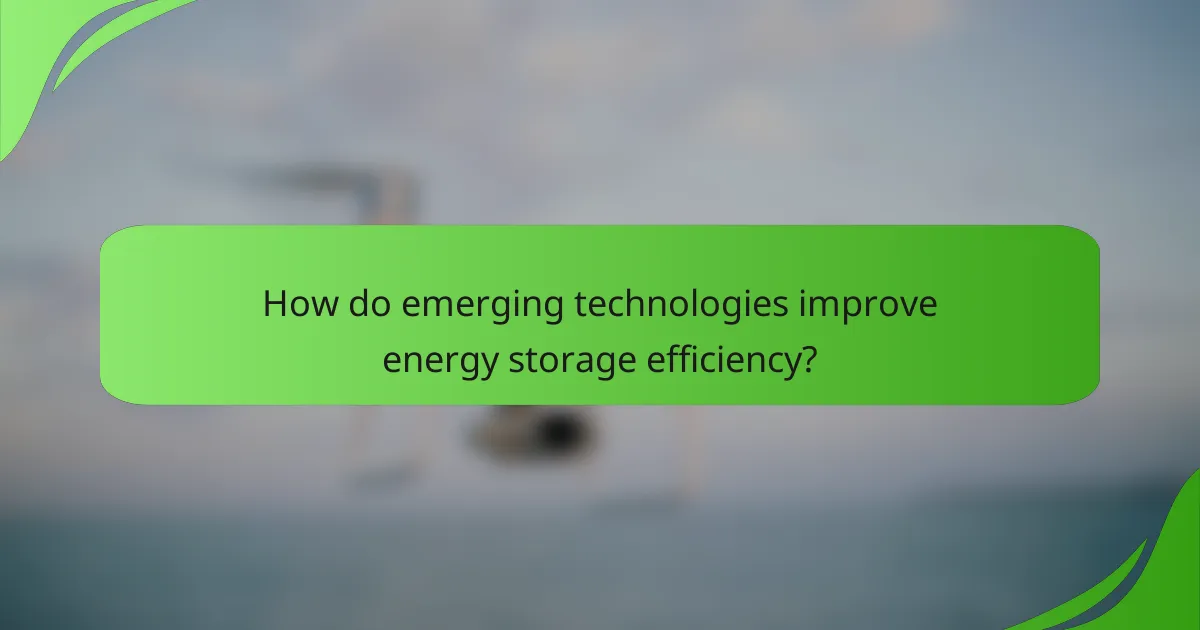
How do emerging technologies improve energy storage efficiency?
Emerging technologies enhance energy storage efficiency by optimizing performance, extending lifespan, and reducing costs. Innovations in battery management systems, artificial intelligence, and nanotechnology are key drivers in this evolution, enabling more effective energy use and storage solutions.
Advanced battery management systems
Advanced battery management systems (BMS) play a crucial role in improving energy storage efficiency by monitoring and controlling battery performance. They ensure optimal charging and discharging cycles, which can extend battery life and enhance safety. Features like temperature regulation and state-of-charge estimation are essential for maximizing efficiency.
For instance, a well-designed BMS can reduce energy losses during charging by up to 10%, making it a vital component in electric vehicles and renewable energy applications. Users should look for BMS that offer real-time data analytics to better manage energy resources.
Artificial intelligence for energy optimization
Artificial intelligence (AI) significantly boosts energy storage efficiency by analyzing vast amounts of data to optimize energy usage patterns. AI algorithms can predict energy demand and adjust storage operations accordingly, leading to improved load management and reduced costs. This technology is particularly beneficial in integrating renewable sources like solar and wind into the grid.
For example, AI can forecast energy production from solar panels based on weather patterns, allowing for better alignment of energy storage and consumption. Implementing AI-driven solutions can lead to efficiency gains of 15-20% in energy management systems.
Nanotechnology in battery materials
Nanotechnology enhances battery materials, leading to improved energy density and faster charging times. By manipulating materials at the nanoscale, researchers can create batteries that store more energy in a smaller footprint, which is crucial for portable devices and electric vehicles. Innovations like silicon nanowires and graphene composites are at the forefront of this development.
These advanced materials can increase battery capacity by up to 30% compared to traditional lithium-ion batteries. When considering new battery technologies, look for those that incorporate nanomaterials for better performance and longevity.
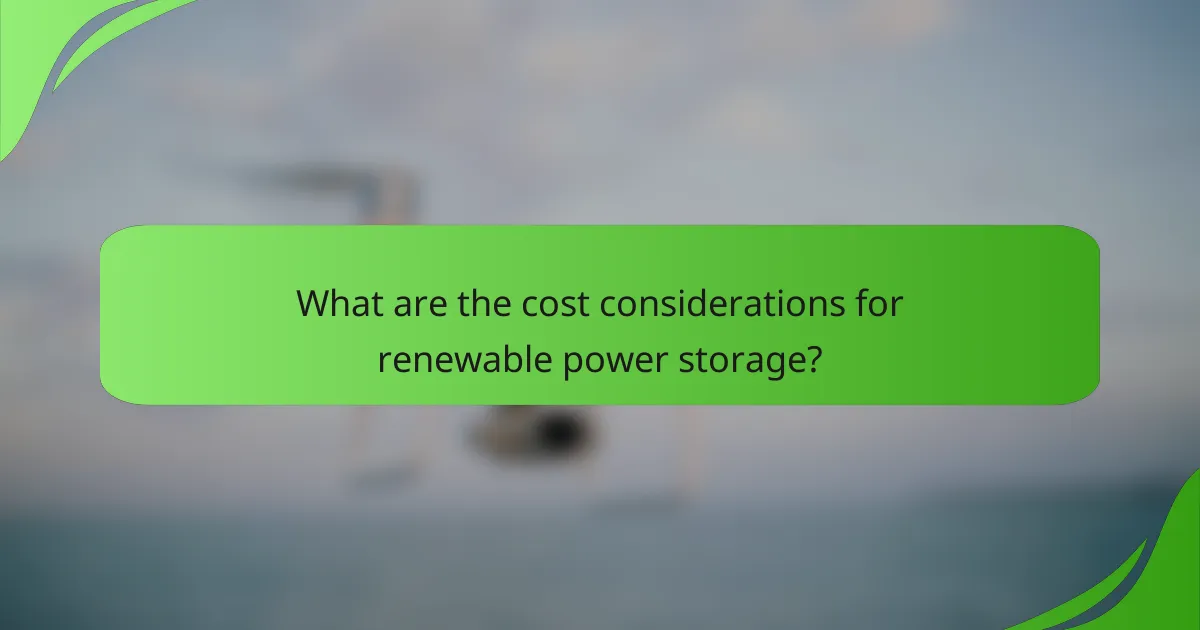
What are the cost considerations for renewable power storage?
Cost considerations for renewable power storage include initial investments, ongoing operational expenses, and potential long-term savings. Understanding these factors is crucial for evaluating the financial viability of different storage technologies.
Initial investment for lithium-ion systems
The initial investment for lithium-ion battery systems can be significant, often ranging from several hundred to over a thousand USD per kilowatt-hour (kWh) of storage capacity. This upfront cost is influenced by factors such as battery chemistry, scale of deployment, and manufacturer pricing.
While lithium-ion systems are becoming more affordable due to advancements in technology and increased production, they still represent a substantial capital outlay. It’s essential to compare these costs against the expected lifespan and performance of the batteries to assess their overall value.
Operational costs of pumped hydro
Pumped hydro storage typically has lower operational costs compared to other storage technologies, often amounting to a few dollars per megawatt-hour (MWh) for maintenance and energy losses. This makes it an attractive option for large-scale energy storage.
However, the feasibility of pumped hydro is highly dependent on geographical location, as it requires specific topographical features. Additionally, initial setup costs can be high, but the long operational lifespan can lead to cost-effective solutions over time.
Long-term savings from energy storage
Investing in energy storage can lead to significant long-term savings by enabling better management of energy supply and demand. For instance, energy storage allows users to store excess renewable energy generated during peak production times and use it during periods of high demand, reducing reliance on more expensive fossil fuels.
Moreover, with the potential for grid stability and reduced energy costs, many businesses and homeowners are finding that energy storage systems can pay for themselves within a few years. Evaluating local energy prices and incentives can further enhance these savings, making energy storage a financially sound investment.
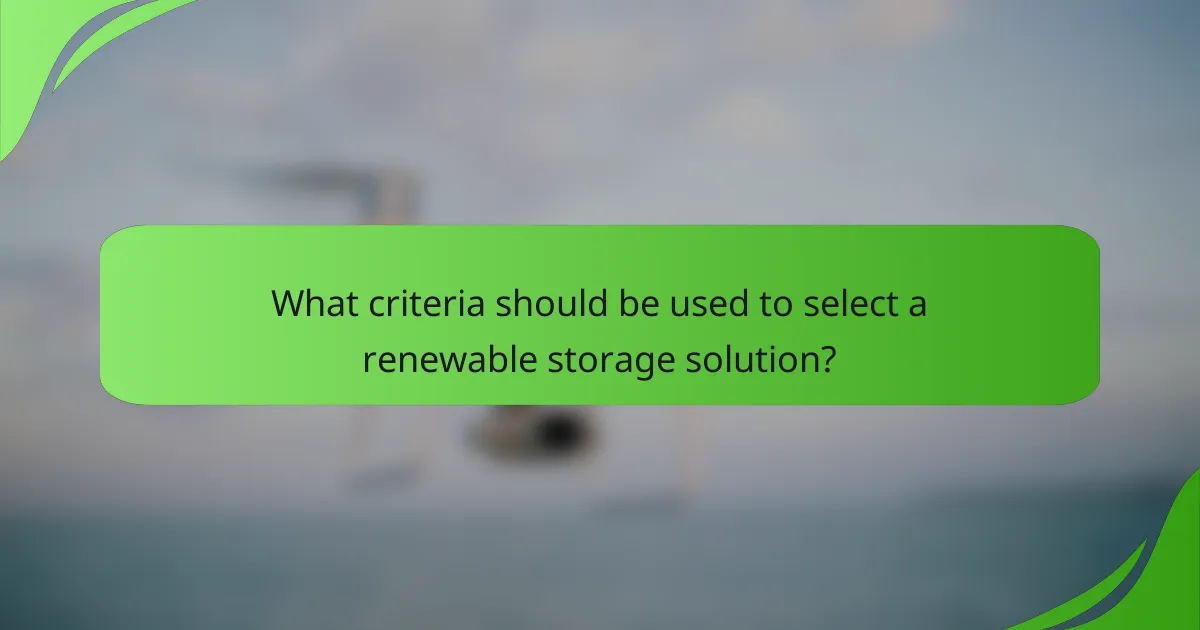
What criteria should be used to select a renewable storage solution?
Selecting a renewable storage solution involves evaluating several key criteria, including capacity, scalability, environmental impact, and available regulatory incentives. These factors help determine the most suitable technology for specific energy needs and local conditions.
Capacity and scalability
Capacity refers to the amount of energy a storage system can hold, while scalability indicates how easily the system can be expanded to meet growing energy demands. When choosing a storage solution, consider technologies like lithium-ion batteries, which typically offer capacities ranging from several kilowatt-hours (kWh) to megawatt-hours (MWh), and can be scaled up by adding more units.
For larger applications, options like pumped hydro storage can provide significant capacity, often exceeding hundreds of MWh. However, these systems may require substantial investment and infrastructure, making them less flexible for smaller projects.
Location and environmental impact
The location of a renewable storage solution can significantly affect its environmental footprint and operational efficiency. For instance, solar battery systems are best suited for areas with high solar irradiance, while wind energy storage is more effective in windy regions. Assessing local climate conditions is crucial for optimizing energy generation and storage.
Additionally, consider the environmental impact of the storage technology itself. Some systems, like lead-acid batteries, have higher environmental risks compared to newer technologies such as flow batteries, which utilize less harmful materials. Evaluating lifecycle assessments can provide insights into the sustainability of different options.
Regulatory incentives and subsidies
Government incentives and subsidies can significantly influence the financial viability of renewable storage solutions. Many countries offer tax credits, grants, or rebates for adopting energy storage technologies, which can reduce upfront costs and improve return on investment. Research local policies to identify available support.
In the United States, for example, the Investment Tax Credit (ITC) allows for a percentage deduction on the cost of solar energy systems, including storage. In Europe, various countries have implemented programs to encourage energy storage adoption, which can vary widely in terms of benefits and eligibility requirements.
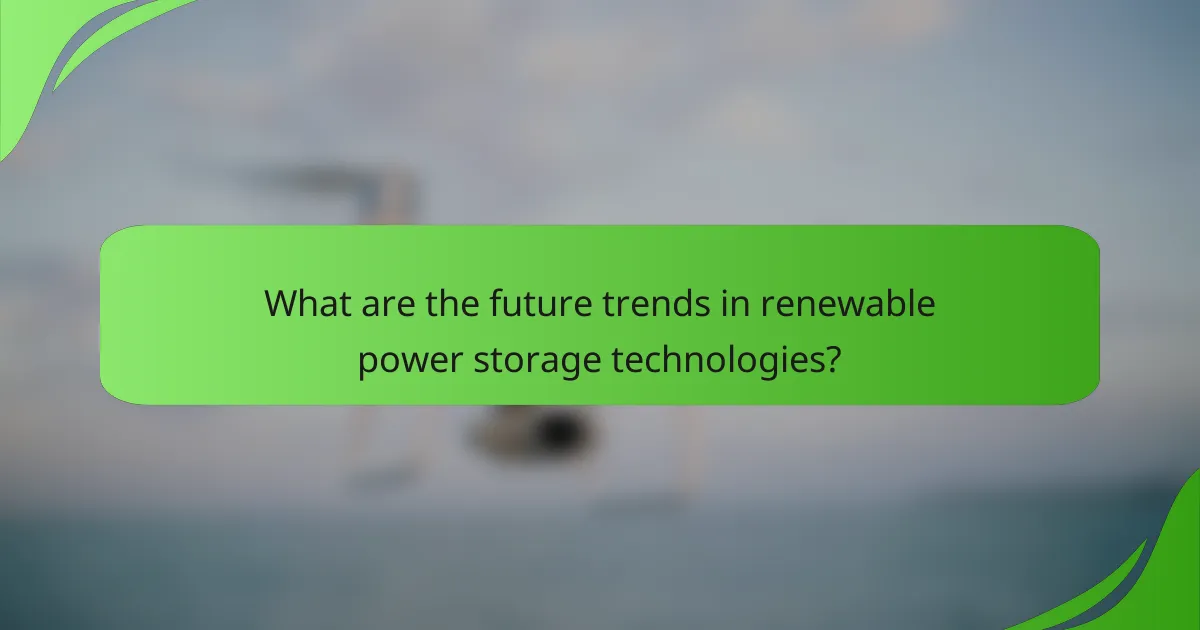
What are the future trends in renewable power storage technologies?
Future trends in renewable power storage technologies focus on enhancing efficiency, scalability, and sustainability. Innovations such as advanced battery systems, hydrogen storage, and thermal energy storage are emerging to meet the growing demand for reliable energy solutions.
Advanced Battery Technologies
Advanced battery technologies, particularly lithium-sulfur and solid-state batteries, are gaining traction due to their higher energy density and safety features. These batteries can potentially offer longer life cycles and faster charging times compared to traditional lithium-ion batteries.
For instance, lithium-sulfur batteries can achieve energy densities of around 500 Wh/kg, significantly higher than current options. This makes them suitable for applications ranging from electric vehicles to grid storage.
Hydrogen Storage Solutions
Hydrogen storage solutions are becoming increasingly viable as a means to store excess renewable energy. By using electrolysis, surplus electricity can be converted into hydrogen, which can then be stored and converted back to electricity when needed.
This method can provide long-term energy storage, making it ideal for balancing seasonal energy demands. Countries like Germany are investing heavily in hydrogen infrastructure to support this transition.
Thermal Energy Storage
Thermal energy storage (TES) systems store energy in the form of heat, allowing for the use of renewable energy even when the sun isn’t shining or the wind isn’t blowing. Common materials for TES include molten salts and phase change materials.
These systems can be particularly effective in concentrated solar power plants, where they can store heat for hours or even days. This capability can help stabilize energy supply and reduce reliance on fossil fuels.
Grid Integration and Smart Technologies
Integrating renewable power storage technologies into the grid is crucial for enhancing reliability and efficiency. Smart grid technologies enable real-time monitoring and management of energy flow, optimizing the use of stored energy.
Investments in smart meters and energy management systems can help consumers and utilities better manage energy consumption and storage. This integration is essential for maximizing the benefits of renewable energy sources and ensuring a stable energy supply.
